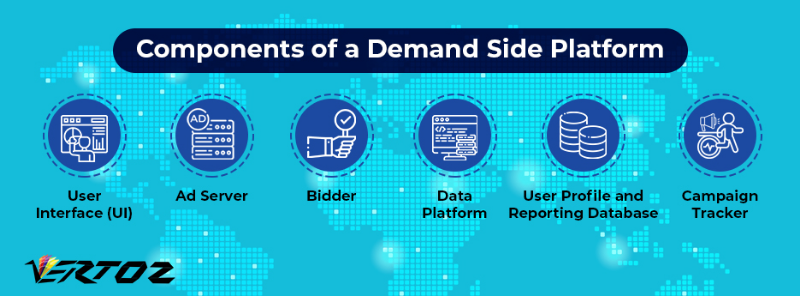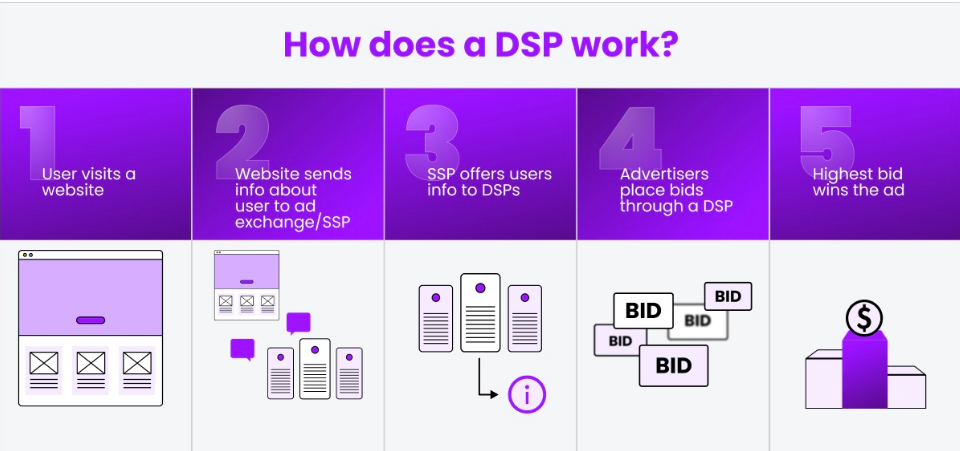What is DSP, and why is it a game-changer in the digital advertising realm for entrepreneurs? In the modern market, not using a Demand-Side Platform (DSP) can leave your digital marketing strategies lagging.
DSPs offer an advanced solution for buying and managing online ad spaces with unprecedented efficiency. This article demystifies DSPs, highlighting their critical role and impact in programmatic advertising.
As an entrepreneur, understanding DSPs can be your key to overcoming advertising challenges and elevating your campaigns.
Take the success story of Sauz Partners, a pasta sauce manufacturer, as an example. With the help of Flying V Group’s expertise in DSP and programmatic advertising, Sauz Partners not only maximized their ad spend efficiency but also achieved significant market penetration, a testament to the power of these digital tools in transforming advertising strategies.
- What is a DSP?
- What Are the Main Components of a DSP?
- Why are Demand-Side Platforms Important?
- How Does a Demand-Side Platform (DSP) Work?
- Embrace the Future of Advertising with Expert Guidance
- FAQs
- What is a DSP platform?
- What are the two types of DSP?
- What is a DSP example?
- What is a Mobile DSP?
- How do DSPs help advertisers buy Ad Space more efficiently?
What is a DSP?
A DSP, or Demand-Side Platform, is a type of software used in digital advertising that enables advertisers and agencies to purchase ad inventory from multiple ad exchanges and platforms through a single interface. Essentially, it’s a tool that automates the buying of online advertising, making the process more efficient and targeted.
DSPs leverage sophisticated algorithms to bid on ad spaces in real-time, allowing advertisers to reach their desired audience at the optimal time and price.
They provide a wealth of data and analytics, helping advertisers to make informed decisions about their campaigns. This data-driven approach ensures that ads are displayed to the most relevant audience, enhancing the likelihood of engagement and conversion.
What Are Examples of Demand Side Platforms?
1. Google Display & Video 360 (DV360): Offers cross-device targeting and analytics, integrated with Google’s advertising network for diverse inventory access.
2. The Trade Desk: Features a user-friendly interface with robust targeting across multiple channels, including mobile and social media.
3. MediaMath: Known for its adaptability and machine learning-enhanced campaign performance, supporting various ad formats.
4. Amazon DSP: Utilizes Amazon’s shopper data for targeted advertising, reaching audiences on and off Amazon platforms.
5. AppNexus (Xandr): Offers a full suite of digital advertising tools with advanced bidding and extensive reporting.
These DSPs provide unique capabilities, from advanced targeting to exclusive inventory access, catering to different advertising needs and objectives in programmatic advertising.
What Are the Main Components of a DSP?

Demand-Side Platforms (DSPs) may vary in specific features and terminologies, but they generally share a common structure to efficiently serve ads in a programmatic environment. Let’s delve into the key components that are typically found in most modern DSPs.
Bidder:
Central to a DSP, the bidder handles the real-time bidding (RTB) on ad impressions. Given that the RTB process happens in milliseconds, speed is paramount. To ensure minimal latency, DSPs often utilize multiple data centers globally. They rely on analytics to make informed bidding decisions based on historical data.
Ad Server:
The ad server in DSPs not only delivers the ads to publishers’ sites but also performs crucial functions like tracking impressions and conversions. This data aids in campaign optimization. Ad servers are also equipped with fraud detection capabilities to identify and block fraudulent ad inventory. DSPs might use their in-house ad servers or integrate with external ones.
Campaign Tracker and Reporting:
An essential feature of DSPs is their ability to monitor and report on various metrics such as impressions, click-through rates (CTRs), conversions, ad viewability, and spending. The insights gathered are displayed on a dashboard and used to refine advertising campaigns.
User Profiling:
DSPs collect data on users as they interact with ads, gradually building detailed user profiles. This data helps categorize users into specific audience segments based on their content preferences, browsing locations, and engagement with ads. These profiles are invaluable for remarketing efforts and further ad optimization.
Budget Manager:
Also known as the banker or cashier in some DSPs, this component allows advertisers to set and manage campaign budgets, including maximum spending limits. It also enables the creation of rules for how budgets are allocated across campaigns.
Integrations:
DSPs are designed to integrate seamlessly with a variety of platforms, including ad exchanges, Supply-Side Platforms (SSPs), data management platforms, analytics tools, payment gateways, and brand safety solutions. These integrations enhance the DSP’s functionality and risk management capabilities.
Ad Exchange and SSP Integration:
One major advantage of using DSPs is the ability to access multiple ad exchanges and SSPs. This integration enables advertisers to streamline the ad-buying process, allowing for extensive cross-channel reach from a single platform. Advertisers typically expect their DSPs to have integrations with multiple ad exchanges and SSPs, broadening the scope of their advertising campaigns.
These components collectively define the operational framework of a DSP, enabling advertisers to execute sophisticated, data-driven ad campaigns with greater efficiency and precision.
Why are Demand-Side Platforms Important?
Demand-Side Platforms (DSPs) are crucial in the digital advertising landscape for several reasons:
• Efficiency in Ad Buying: DSPs streamline the process of purchasing ad inventory by allowing advertisers to buy from multiple ad exchanges through a single interface. This efficiency reduces the time and effort required to manage ad placements across various platforms.
• Real-Time Bidding (RTB): DSPs facilitate real-time bidding, enabling advertisers to bid on ad space in milliseconds. This ensures that advertisers can target the right audience at the right time, maximizing the impact of their ads.
• Targeted Advertising: DSPs offer sophisticated targeting capabilities. Advertisers can specify the audience they want to reach based on demographics, interests, behaviors, and more. This level of targeting ensures that ads are more relevant to the audience, leading to higher engagement and conversion rates.
• Cost-Effectiveness: By using algorithms to bid on ad space, DSPs help advertisers to buy ad inventory at the best possible prices. This automated approach ensures cost-effectiveness, as advertisers are more likely to pay fair prices for ad impressions.
How Does a Demand-Side Platform (DSP) Work?

1. Sign-Up and Integration:
First Step: As an advertiser, you sign up for a DSP service. This typically involves setting up an account and integrating your campaign information, like your target audience, advertising goals, and budget.
2. Campaign Setup:
Second Step: You create your advertising campaign within the DSP. This includes specifying your target audience based on various criteria such as demographics, interests, location, and behaviors. You also set your budget, bidding strategy, and choose the types of ads you want to run (like display, video, or mobile).
3. Connection to Ad Exchanges:
Third Step: The DSP connects to multiple ad exchanges. These are platforms where ad inventory (spaces where ads can be placed) is bought and sold. Your DSP will have access to a wide range of ad spaces across different websites and apps.
4. Real-Time Bidding:
Fourth Step: When a user visits a website or uses an app that has ad space connected to these exchanges, an ad impression (a potential ad view) becomes available.
Fifth Step: The DSP automatically evaluates whether this ad impression matches your campaign criteria. If it does, the DSP enters a real-time bidding (RTB) auction against other advertisers to buy that ad space.
5. Ad Placement:
Sixth Step: If your DSP wins the auction, your ad is instantly placed in the available space. The entire process, from the ad impression becoming available to your ad being displayed, happens in a matter of milliseconds.
6. Performance Tracking and Optimization:
Seventh Step: The DSP collects data on how your ad is performing. Metrics like how many people saw your ad (impressions), clicked on it (clicks), and took a desired action (conversions) are tracked.
Eighth Step: Based on this data, you can make informed decisions to optimize your campaign. This could involve adjusting your targeting criteria, changing your bid strategy, or tweaking your ad creative.
7. Budget Management:
Ninth Step: Throughout the campaign, the DSP manages your budget, ensuring that your spending is within the limits you’ve set and that your money is spent efficiently to achieve the best possible results.
8. Campaign Conclusion and Analysis:
Tenth Step: After your campaign ends, or at regular intervals, you can review comprehensive reports provided by the DSP. These reports give insights into the campaign’s overall performance and can guide future advertising strategies.
Embrace the Future of Advertising with Expert Guidance
Understanding DSPs is just the start. As an entrepreneur, the complexity of programmatic advertising can be overwhelming, posing a challenge to reach your audience and grow your business effectively.
This is where the expertise of the Flying V Group becomes your solution. Specializing in digital marketing, they simplify the complexities of DSPs, ensuring your advertising strategies are both effective and efficient. Partner with us to turn the challenges of digital advertising into opportunities for growth and success.
FAQs
What is a DSP platform?
A DSP, or Demand-Side Platform, is a software system that allows advertisers to buy digital ad space across various media outlets automatically. It streamlines the ad buying process using real-time bidding, targeting specific audiences efficiently.
What are the two types of DSP?
Two types of DSPs are standalone DSPs, which are independent platforms focusing solely on ad buying, and integrated DSPs, which are part of larger marketing or ad tech suites.
What is a DSP example?
An example of a DSP is Google’s Display & Video 360 (DV360), which allows advertisers to manage and buy digital ad inventory across multiple ad exchanges and formats through a single platform.
What is a Mobile DSP?
A Mobile DSP is a Demand-Side Platform specifically designed for purchasing ad inventory on mobile devices. It enables advertisers to target mobile users with more precision, utilizing data specific to mobile usage.
How do DSPs help advertisers buy Ad Space more efficiently?
DSPs use advanced algorithms and data analytics for real-time bidding and precise audience targeting, making ad space purchases more efficient. They consolidate various ad inventories into a single platform, simplifying the buying process and optimizing ad spend.






0 Comments